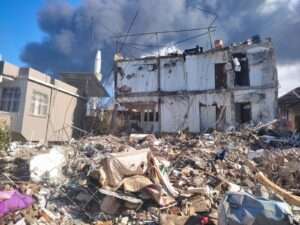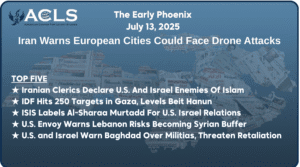
On the night of February 8-9, more than 72 hours after the initial 7.8 magnitude earthquake that struck southern Turkey and northern Syria, the stricken areas of northwest Syria have still received no external assistance whatsoever.
Local communities and rescue teams fear that as the hours elapse past the 72-hour window in which rescue is most likely, hope is dwindling for reaching the large numbers of civilians still trapped under rubble in towns such as Jindaris, Atarib, and Salqin. The rescue effort in northwest Syria has been intense, but has lacked enough personnel, equipment, and external support to address the scale of the disaster. Despite Syrians’ repeated urgent appeals for heavy equipment, rescue teams, and direct support to the Syrian Civil Defense (“White Helmets”), nothing has arrived by the time of drafting this report.
Mazen Alloush, Director of Media Relations at the Bab al-Hawa border crossing between Turkiye and Syria, informed ACLS on the evening of February 8 that no medical teams, rescue crews, equipment, or humanitarian aid had entered through Bab al-Hawa since the earthquake began. Alloush noted that the only transport through the crossing had been the delivery of approximately 350 deceased Syrians who had died in the quake inside Turkiye and were being delivered back to Syria for burial. Alloush added that Bab al-Hawa personnel expected a UN delivery of six trucks with cleaning materials and diapers on the morning of February 9.
In the absence of international assistance, the White Helmets and citizen volunteers have continued rescue operations and searches for missing persons under rubble in difficult conditions. As of the early morning of February 9, Syria TV reported that the death toll inside Syria has reached 3,042, with this figure likely to rise significantly due to the presence of hundreds of families still trapped or dead under the rubble of destroyed buildings and homes. According to the White Helmets on February 8, more than 1,730 of these fatalities have been in the liberated areas of northwest Syria.
Beyond the lack of emergency rescue capacity, a major factor still causing casualties to rise is the remaining number of damaged, unstable buildings and the continuing occurrence of serious aftershocks. As of late February 8, the total number of collapsed buildings in northwest Syria has risen to 378, with another 1,045 partially collapsed and thousands more buildings damaged or unstable.
The World Health Organization (WHO) has warned that the final death toll across the stricken regions of both countries could be more than 20,000, although this figure is beginning to appear conservative as the death toll rises rapidly. The WHO estimated that as many as 23 million people across Turkey and Syria may have been affected by the tragedy.
According to rescue team leader Ahmed Al-Youssef, as of February 8 the White Helmets have pulled more than 300 civilians, including 60 women, 80 children, and 160 young men and women, from the rubble. Most of the deceased among this number have been buried in mass graves.
Journalist Ahmed Rahal, meanwhile, said that rescuers and volunteers now find that the voices of people calling for help from under the rubble have begun to fade after many hours with no rescue response. Rahal noted that in the past, when the civil defense teams responded to aerial bombing targets hit by the Syrian regime or Russian warplanes, they often worked for two or three days to rescue those trapped at a single targeted building, but now they face the task of literally hundreds of buildings completely destroyed. Rahal said it is also painful when you see the people searching for their loved ones under the rubble and hearing their voices, but being forced to stand without offering any assistance to those trapped because rescue teams are not available. This feeling is the harshest situation you can see in front of your eyes, Rahal added. Civilians are left with no recourse but to use primitive equipment to smash stones and try to remove rubble from those trapped under collapsed buildings.
In addition to those who have been trapped since the first earthquake, many casualties occurred after the initial tremors because civilians who lacked experience with earthquake disasters made the mistake of entering damaged buildings to search for missing persons, only to perish themselves in aftershocks. Casualties of this kind took place on February 8 in several towns, including Janderis and Atarib.
Finally, for the past three days, the White Helmets have faced the impossible task of covering an area of northwest Syria with more than four and a half million inhabitants. Speaking to ACLS, White Helmets Deputy Director General Munir Al-Mustafa warned, “After 72 hours have passed, the lack of aid, equipment, machinery, and support will be the reason for our inability to extract those trapped alive from under the rubble, because the chances of survival for the injured are non-existent and very rare.” The most important equipment the rescue teams need is engineering machinery such as cranes, packers, and movers, as well as modern rescue equipment and the basic supplies to maintain all these kinds of equipment, none of which has yet arrived in northwest Syria. Mustafa added that the civil defense teams are also in urgent need of financial aid to cover expenses for vehicles, fuel, and emergency repairs that occur because the rescue equipment must be operated around the clock. He said that the White Helmets fear the aid will not arrive in time to avoid the loss of lives of hundreds of civilians who could otherwise be saved.
Mahmoud al-Bakour is an ACLS researcher and contributor writing from on the ground inside northwest Syria. He has experienced the earthquake and aftermath of the past three days directly.



